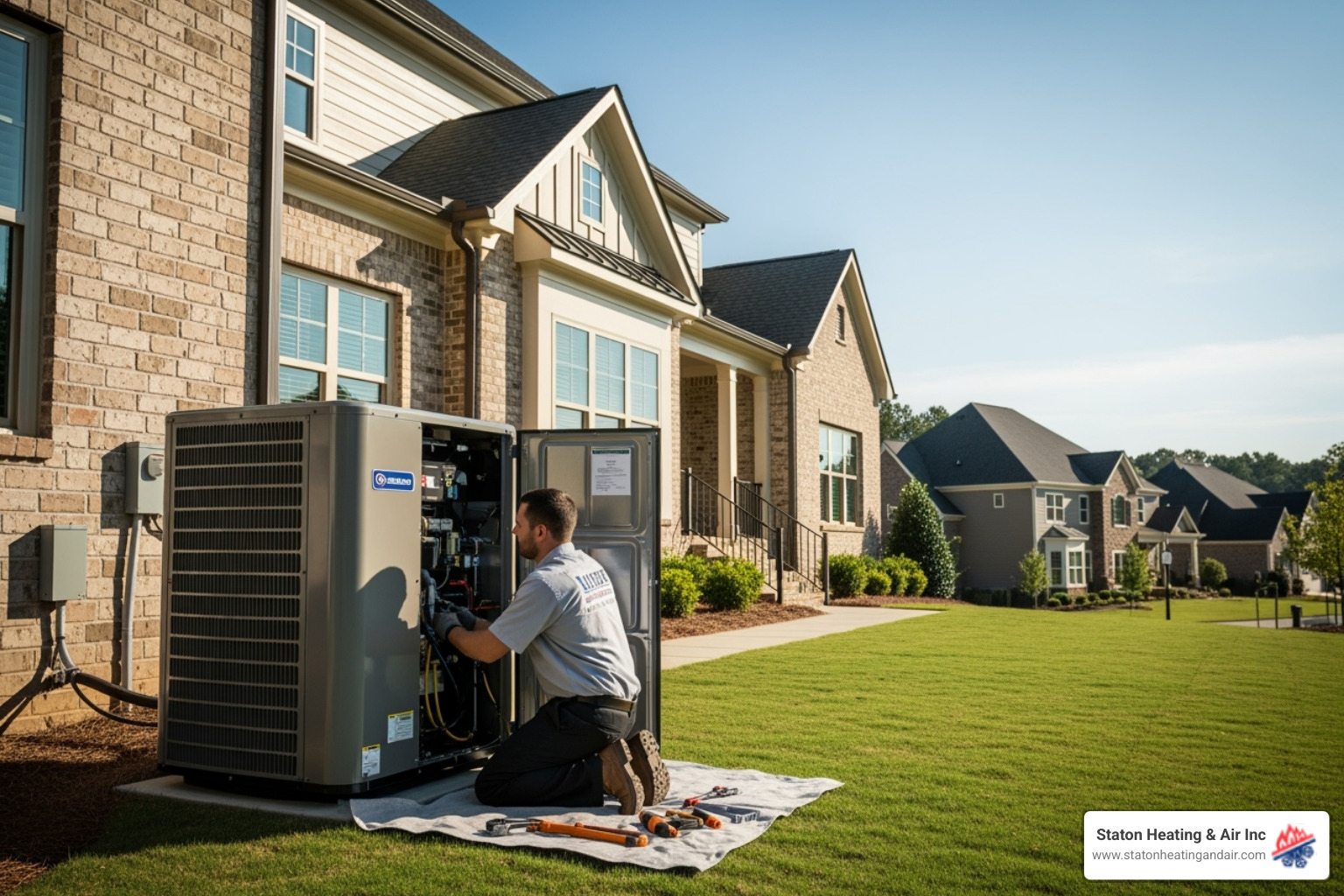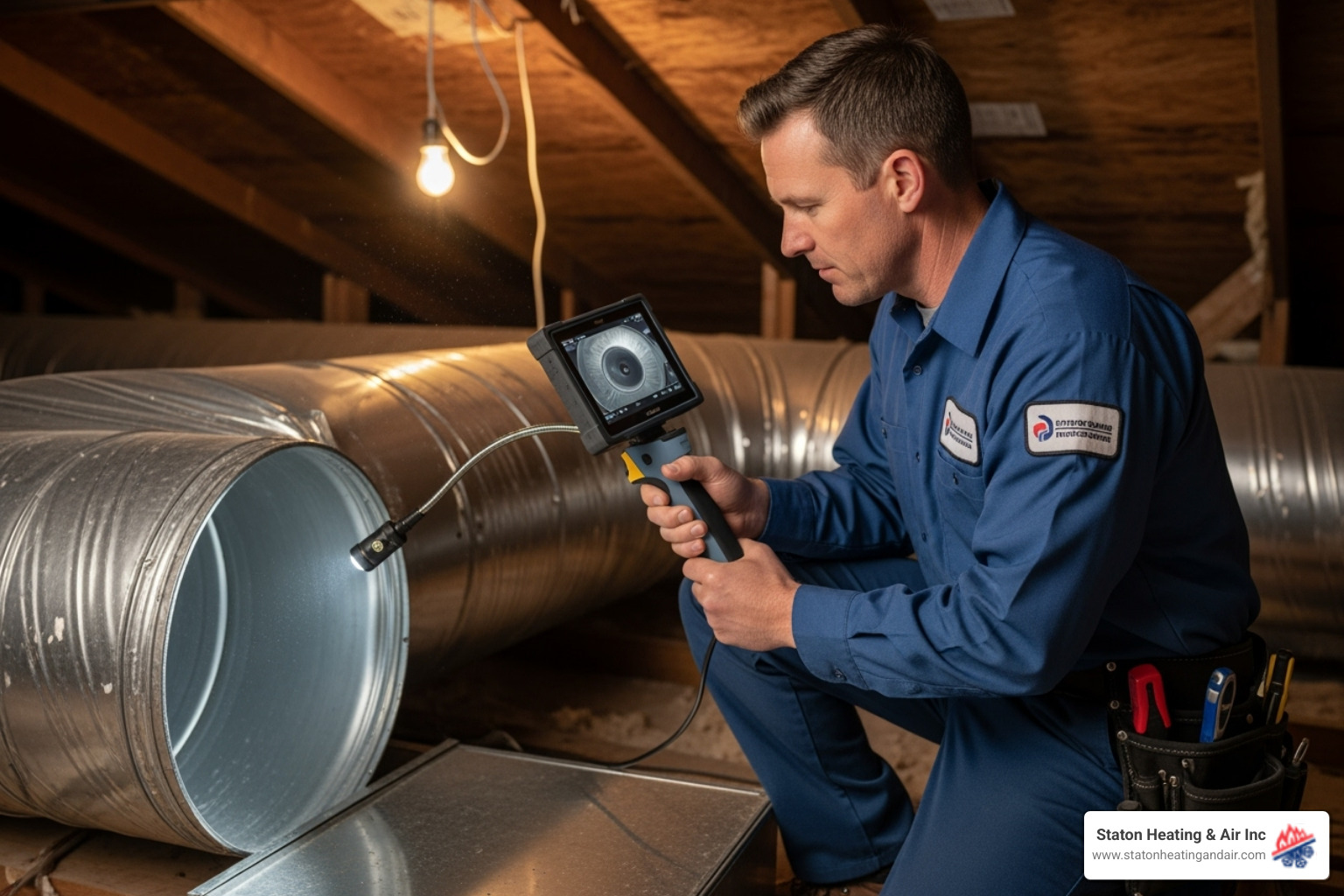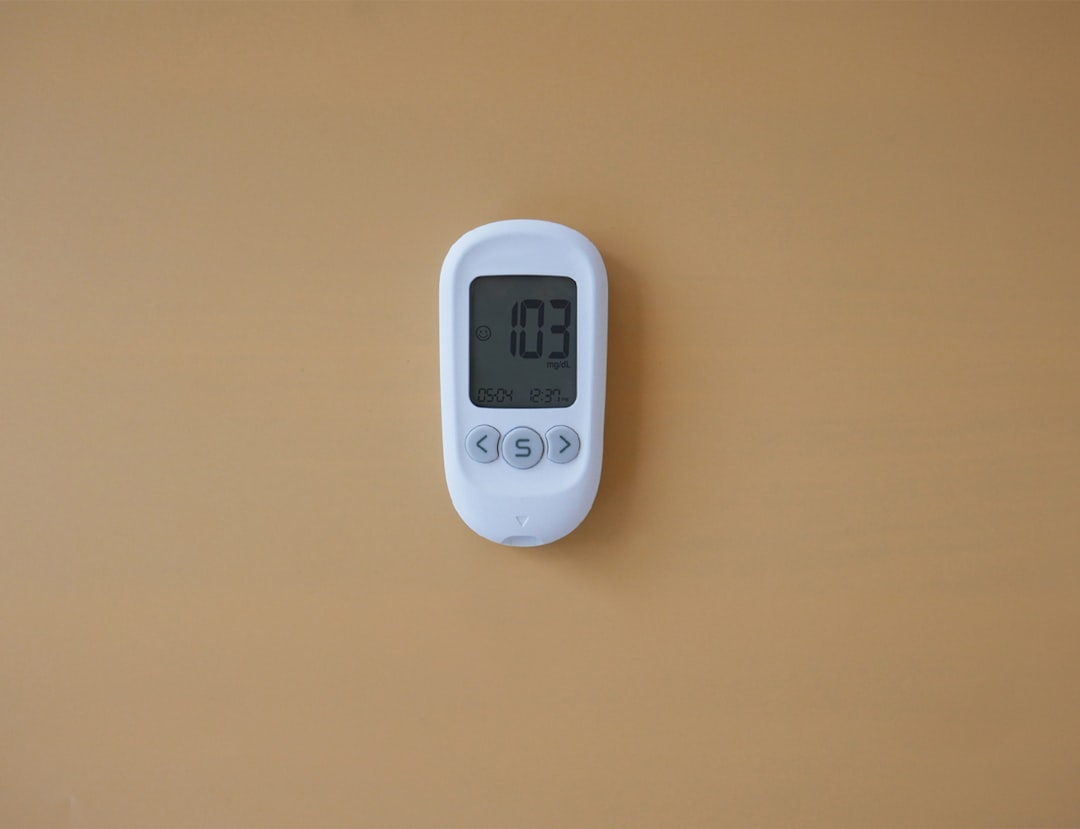AC Drain Line Clogged? Here's Your DIY Fix
Your Air Conditioner's Unsung Hero: The Condensate Drain Line
When your AC drain line gets clogged, it can shut down your entire cooling system and cause expensive water damage to your home. This small PVC pipe plays a huge role in keeping your air conditioner running smoothly by carrying away the moisture your AC creates during normal operation.
Quick Answer: What is an AC Drain Line?
- Function: Removes condensation water from your air conditioner
- Location: Usually a PVC pipe near your indoor air handler unit
- Purpose: Prevents water damage and keeps your AC running efficiently
- Common Problems: Clogs from algae, mold, and debris that can shut down your system
Your air conditioner works by cooling warm, humid air over cold evaporator coils. This process creates condensation - just like a cold glass of water on a hot day. That water has to go somewhere, and that's where your condensate drain line comes in.
The drain line carries this water away from your home through a simple gravity-fed system. When it works properly, you'll never think about it. But when it gets clogged with algae, mold, or debris, you'll know right away - either from water pooling around your unit, musty smells, or your AC shutting down completely.
Most clogs happen gradually as dust, algae, and sludge build up inside the pipe. Dirty air filters make the problem worse by allowing more debris to reach your evaporator coils. The good news? Most homeowners can clear these clogs themselves with basic tools and a little know-how.
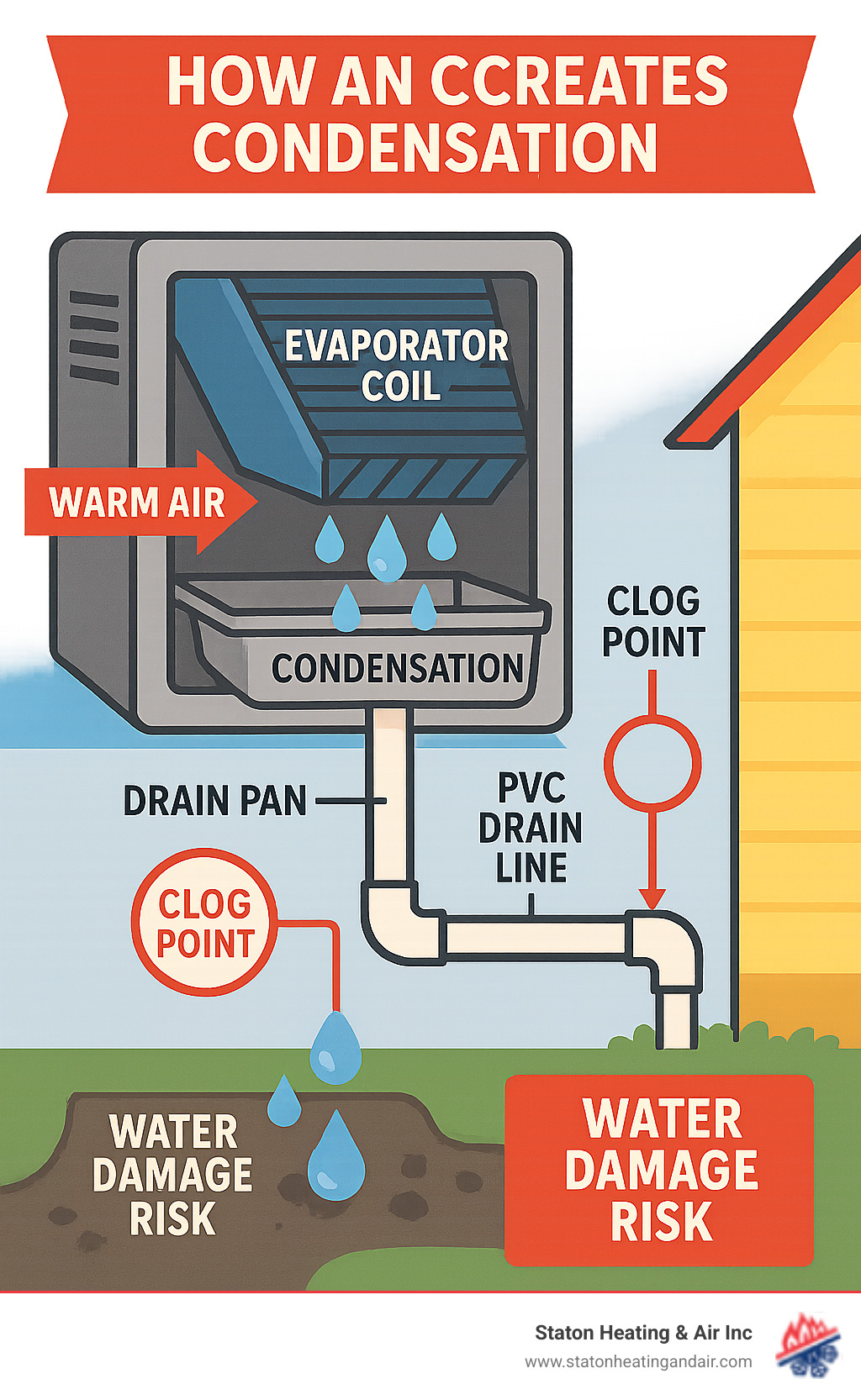
What is an AC Condensate Drain Line?
At the heart of your air conditioning system is the evaporator coil, a cold component that warm, humid indoor air passes over. As the air cools, moisture in it condenses into tiny water droplets. This process is how your AC removes humidity from your home, making the air feel cooler and more comfortable.
These water droplets collect in a condensate drain pan, usually located directly beneath the evaporator coil. From there, the water flows into the AC drain line (also known as the condensate drain line), a small pipe typically made of PVC. This pipe is designed to carry the collected moisture away from your AC unit and out of your home, either to a floor drain, a utility sink, or directly outside.
The primary function of the AC drain line is moisture removal. Without it, the water would simply overflow the drain pan, leading to potential water damage to your home's structure, ceilings, walls, and even the AC unit itself. It's crucial for effective humidity control, which is a key part of your AC's job. By efficiently removing this moisture, the drain line ensures your HVAC system operates properly and maintains a healthy indoor environment. If you're curious about the mechanics, you can learn more about how air conditioners work.
Why Does it Get Clogged?
The environment inside your AC drain line is, unfortunately, a perfect breeding ground for trouble. It's dark, moist, and often warm, creating ideal conditions for organic growth. The most common culprits behind a clogged AC drain line include:
- Algae and Mold Growth: These microorganisms thrive in the damp conditions of the drain line. Over time, they form a slimy, gel-like buildup that restricts water flow and eventually causes a blockage. This is particularly prevalent in humid climates like ours in Metro Atlanta.
- Sludge and Sediment: As water evaporates or flows through the line, it can leave behind mineral deposits, dust, dirt, and other sediment. This forms a thick sludge that accumulates along the pipe walls.
- Dust and Debris: Your AC system pulls in air from your home, and even with filters, tiny particles of dust, pet dander, and other airborne debris can make their way to the evaporator coil. When this debris mixes with condensation, it can get washed into the drain pan and eventually into the drain line, contributing to clogs.
- Dirty Air Filters: This is a major factor. When your air filters are dirty and clogged, they can't effectively trap airborne particles. This allows more dust and debris to reach your evaporator coil, where it mixes with the condensation and gets flushed into the drain line, accelerating clog formation. We recommend changing your air filters every three months to prevent this.
- External Factors: While less common for indoor units, outdoor sections of the drain line can also be affected by leaves, dirt from rain, or even small critters. Extreme temperatures can also play a role; for example, if coils freeze and then rapidly melt, the sudden rush of water can carry more debris into the line.
A clogged AC drain line is a fairly common cause of system malfunction. Understanding what causes these blockages is the first step in preventing them and keeping your system running efficiently.
Telltale Signs of a Clogged AC Drain Line
Your air conditioner has its own way of crying for help when the AC drain line gets clogged. The good news? It's usually pretty obvious when something's wrong. The bad news? Ignoring these warning signs can turn a simple maintenance task into a major headache - and an expensive repair bill.
Think of your AC like a friend who's trying to tell you something's wrong. It might start subtle, but it'll get louder and more dramatic until you pay attention. Here's what to watch for:
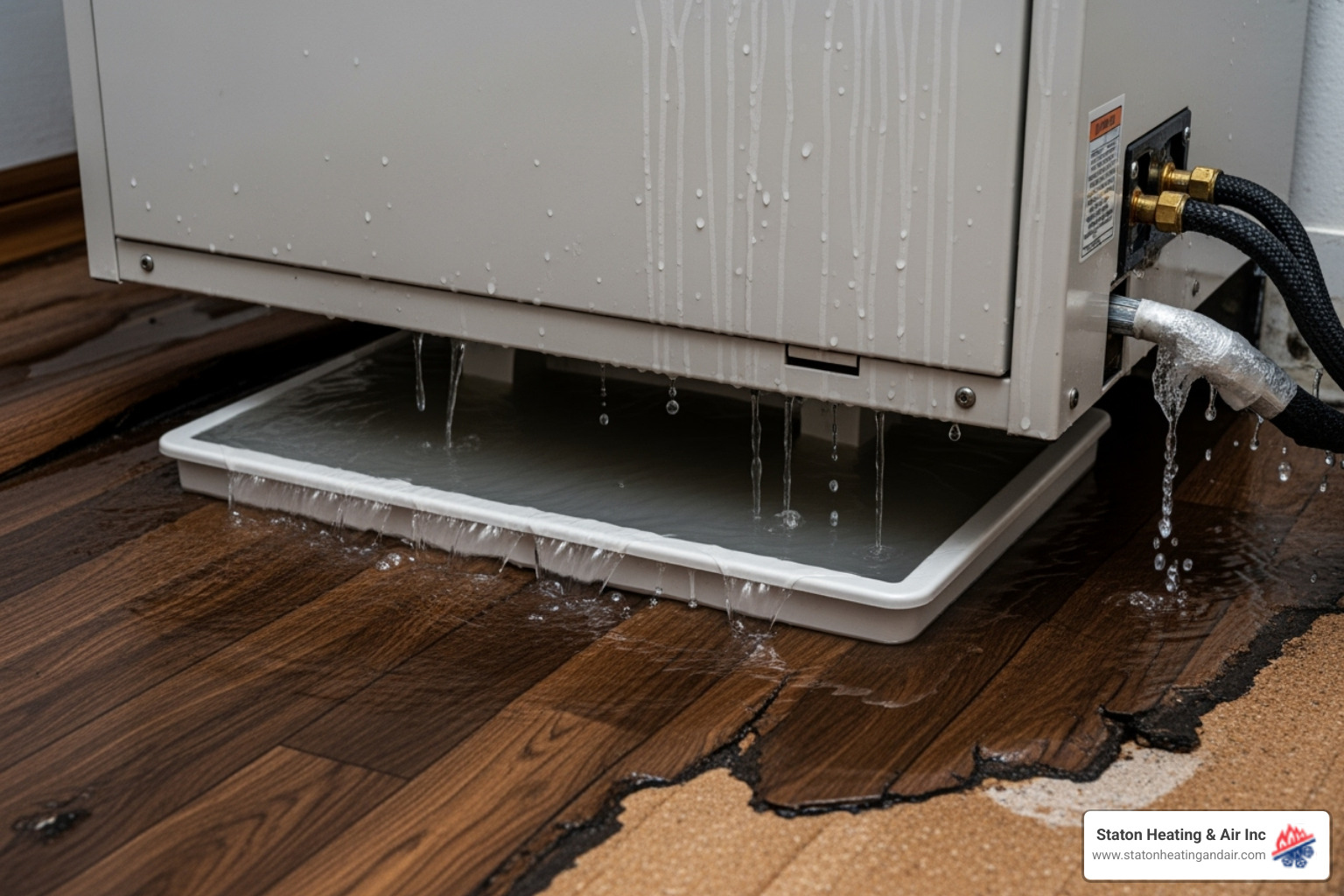
Water Damage and Leaks
Water showing up where it doesn't belong is your AC drain line waving a big red flag. When the line gets clogged, all that condensation has to go somewhere - and unfortunately, that "somewhere" is usually your home.
Standing water around your indoor unit is the most obvious sign. You might find puddles near your air handler in the basement, utility closet, or wherever your indoor unit lives. Sometimes the water sits right in the drain pan itself, like a bathtub that won't drain.
If your air handler is tucked away in the attic, you might not see the water directly. Instead, you'll notice stains on your ceiling or walls - those telltale yellowish or brownish marks that seem to appear out of nowhere. The drywall might feel soft or spongy when you touch it. That's water damage in action, and it's not going to fix itself.
Take a peek at your drain pan if you can reach it safely. A rusted drain pan tells the story of water that's been sitting there way too long. Rust doesn't happen overnight - it's a sign that your drain line has been struggling for a while.
Your AC Unit Shuts Down Unexpectedly
Here's where your AC gets dramatic. Modern systems are pretty smart - they know when something's wrong and they'll shut themselves down to prevent bigger problems.
Most AC units have a safety float switch that acts like a bouncer at a nightclub. When water levels get too high in the drain pan, this little device says "nope, we're done here" and shuts down the whole system. It's actually protecting your home from major water damage, even though it feels frustrating when your AC quits on the hottest day of the year.
When this happens, you might find no cool air coming from your vents, or your system won't turn on at all. Your thermostat might be blank or showing an error message that looks like it's speaking a foreign language. You might also hear clicking noises as the system tries to start up but gets shut down by the safety switch.
Even before a complete shutdown, a partially clogged AC drain line can cause problems. Your home might feel unusually sticky or humid because your AC isn't removing moisture properly. And those musty odors coming from your vents? That's mold and mildew having a party in the standing water - definitely not the kind of party you want in your home.
The bottom line is simple: when your AC starts acting up, especially if it shuts down unexpectedly, a clogged drain line is often the culprit. The sooner you address it, the sooner you can get back to being comfortable in your own home.
How to Unclog Your AC Drain Line: A Step-by-Step Guide
Nobody wants to deal with water dripping through their ceiling or an AC drain line that's backed up with gross sludge. The good news? Most clogs aren't as scary as they look, and you can probably tackle this yourself with some basic tools and a little patience.
Before we jump into the fun stuff (and yes, there's something oddly satisfying about clearing a stubborn clog), let's talk safety. Always turn off the power to your AC unit before you start any maintenance work. This means flipping the switch at your thermostat AND turning off the breaker at your electrical panel. Trust us on this one.

Essential Tools for Cleaning Your AC Drain Line
Think of this as your AC drain line rescue kit. Having everything ready before you start will save you from running around the house looking for tools while water is dripping everywhere.
Your most important tool is a wet/dry vacuum - this little powerhouse will suck out even the most stubborn clogs. Make sure it's actually rated for wet use, because you'll definitely be dealing with water. A stiff wire brush or bottle brush helps you break up debris right at the access point, while a funnel makes pouring cleaning solutions much less messy.
For the actual cleaning, distilled white vinegar is your best friend. It kills mold and algae naturally without the harsh chemicals that can damage your PVC pipes over time. Skip the bleach - it might seem stronger, but it can actually corrode your pipes and create dangerous fumes.
Don't forget the basics: rags or towels for cleanup, a bucket to catch any spills, and some duct tape to create a tight seal when you're using the vacuum. These simple tools will handle most clogs you'll encounter.
Locating the Drain Line and Access Point
Finding your AC drain line is like a treasure hunt, except the treasure is a PVC pipe full of questionable gunk. Start by locating your indoor air handler - that's the big boxy unit inside your home, usually tucked away in an attic, basement, utility closet, or garage.
Look underneath the evaporator coil section (you might need to remove an access panel) to find the condensate drain pan. If your line is clogged, this pan will probably be full of standing water. From there, you'll see a PVC pipe leading away - that's your AC drain line.
The magic happens at the T-shaped PVC vent cap along the drain line. This little access point is where you'll do most of your cleaning work. It's designed to let you pour cleaning solutions in and clear blockages without taking apart your whole system.
Follow that pipe to where it exits your home - usually near your outdoor condenser unit or along a foundation wall. This outdoor drain exit is where you'll attach your wet/dry vacuum for maximum suction power.
The Cleaning Process
Now comes the satisfying part - actually clearing that clog and getting your AC drain line flowing like new again.
Step 1: Turn off power at both your thermostat and your electrical breaker box. If you have an outdoor unit, look for a service disconnect switch near it and turn that off too. This keeps you safe while you work.
Step 2: Clear the access point by removing that T-shaped PVC cap we found earlier. Don't be surprised if you see standing water or some pretty gross buildup right at the opening. Use your rags to soak up any overflow from the drain pan, and gently clear visible debris with your wire brush.
Step 3: Use a wet/dry vac at the outdoor end of your drain line. Create a tight seal over the pipe opening with your vacuum hose - duct tape helps here. Run the vacuum for 2-3 minutes and listen for debris being sucked out. You might be amazed (and slightly horrified) by what comes out of that pipe.
Step 4: Flush with vinegar by pouring about one cup of distilled white vinegar through the indoor access point using your funnel. Let it sit for at least 30 minutes - longer if you have time. The vinegar breaks down algae, kills mold, and dissolves sludge buildup naturally.
Step 5: Final water flush with a few cups of hot water (not boiling - that could damage PVC pipes) down the same access point. Add a drop of dish soap for extra cleaning power. Have someone watch the outdoor end to confirm water is flowing freely.
Step 6: Test the system by replacing the PVC cap, turning the power back on, and setting your thermostat to cool. Monitor everything for the next few hours to make sure water is draining properly and your AC isn't shutting down again.
If water is still backing up after all this work, the clog might be more severe than a DIY approach can handle, or there could be another issue with your system.
Prevention and Professional Maintenance
Clearing a clogged AC drain line yourself is a great accomplishment, but an ounce of prevention is worth a pound of cure! Regular maintenance can save you from future headaches and costly repairs.
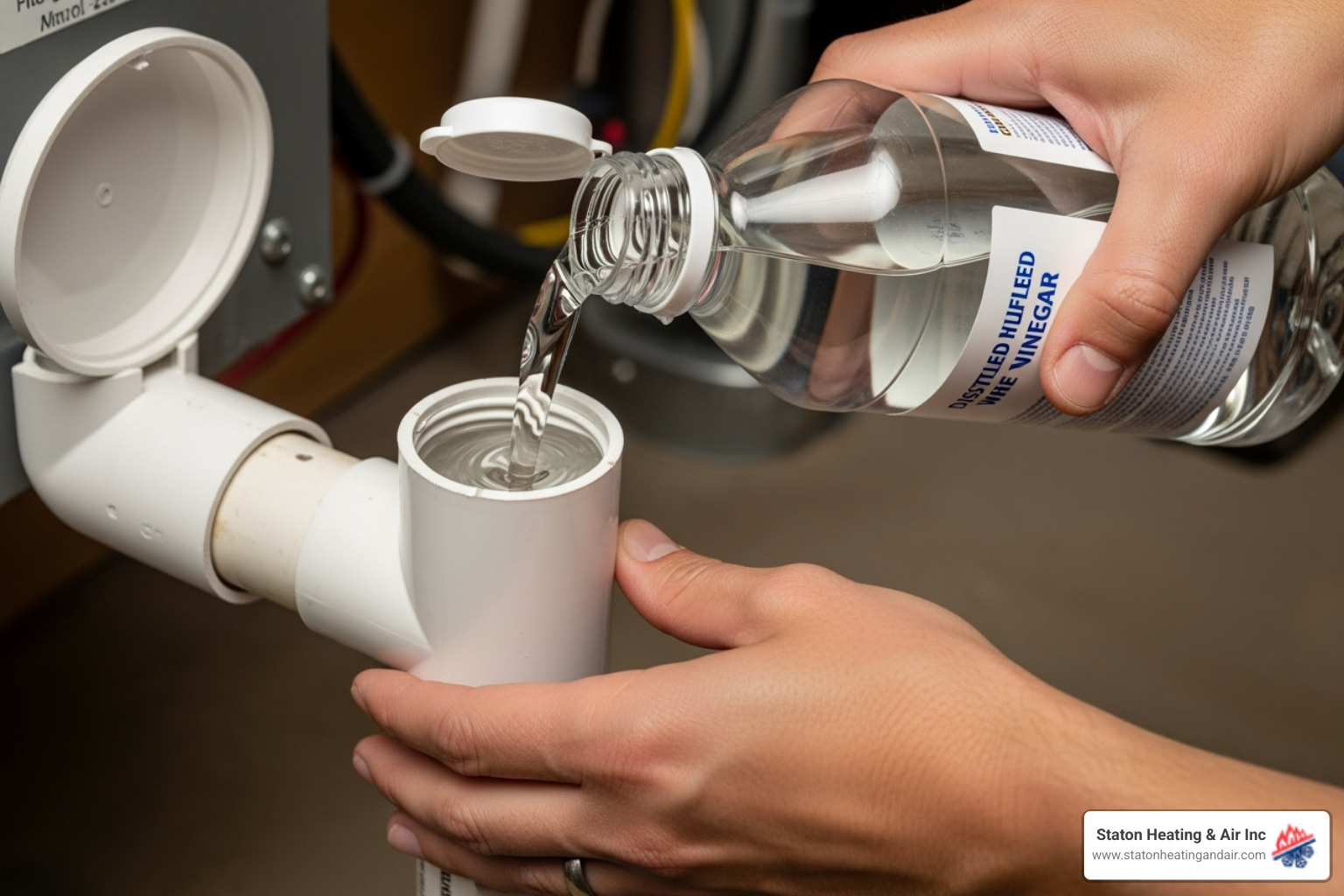
Preventing Future Clogs in Your AC Drain Line
Think of AC drain line maintenance like brushing your teeth - a little effort now prevents big problems later. The best news? Most prevention steps take just a few minutes and cost almost nothing.
Monthly or quarterly vinegar flushes are your secret weapon against future clogs. Simply pour 1/4 to 1 cup of distilled white vinegar down your AC drain line access point every 1 to 3 months. This natural cleaner kills algae, mold, and bacteria before they can form serious blockages. It's especially important here in Georgia's humid climate, where biological growth happens fast.
Changing your air filters regularly might be the single most important thing you can do. When filters get dirty and clogged, they let dust, dirt, and debris reach your evaporator coil. All that gunk gets washed into your drain pan and eventually clogs your line. We recommend swapping out filters every three months - or even more often if you have pets, allergies, or live somewhere dusty.
Condensate pan tablets offer another layer of protection. These slow-release tablets dissolve over time, preventing algae and bacteria from growing in your drain pan. Just drop one or two tablets in your drain pan (away from the drain opening) every few months, and they'll do the work for you.
Don't forget about the outdoor exit point of your AC drain line. Keep it clear of leaves, dirt, grass clippings, and other debris. A blocked exit can cause water to back up through your entire system, even if the internal line is perfectly clean.
If your AC doesn't already have a safety float switch, consider having one installed. This smart little device automatically shuts off your system if water levels get too high, preventing expensive water damage to your home.
DIY vs. Professional Cleaning
While many homeowners can successfully tackle minor AC drain line clogs, sometimes calling in the pros is the smartest move. Here's how to decide what's right for your situation.
DIY cleaning works great when you're dealing with routine maintenance or minor blockages. The effort is low to moderate, and your costs are minimal - basically just some vinegar and maybe renting a wet/dry vac if you don't own one. You'll use basic household items and follow the steps we outlined earlier. It's a quick fix that can save you money on service calls.
However, DIY methods have their limits. They're good for minor clogs and preventative maintenance, but there's always a risk of incomplete clog removal. If you're not careful, you could accidentally damage your system.
Professional cleaning brings a whole different level of expertise to the table. Our NATE-certified technicians use specialized tools like nitrogen tanks, CO2 cartridges, power augers, and even video inspection cameras to diagnose and clear stubborn clogs. While the upfront cost is higher than DIY, professionals can handle severe, persistent, or hard-to-reach clogs that would stump most homeowners.
The biggest advantage of professional service? Thorough diagnosis and addressing underlying issues. We don't just clear the clog - we figure out why it happened and help prevent it from coming back. Our work comes with warranties, and we can spot potential problems before they cause expensive damage to your home.
When should you call the pros? If you've tried DIY methods and the clog keeps coming back, that's a red flag. Strong moldy smells, signs of significant water damage, or clogs in hard-to-reach locations are all good reasons to pick up the phone. And honestly, if you're just not comfortable crawling around your attic or working with electrical equipment, there's no shame in calling for help.
The bottom line: DIY is perfect for routine maintenance and simple clogs, but don't hesitate to call professionals when the situation calls for it. Your AC drain line - and your peace of mind - will thank you.
Frequently Asked Questions about AC Drain Lines
We get tons of questions about AC drain lines from homeowners throughout Cumming and Metro Atlanta! After 50+ years in the business, we've pretty much heard it all. Here are the ones that come up most often.
How often should I clean my AC drain line?
Here's the thing about AC drain line maintenance - a little prevention goes a long way, especially here in Georgia where our humidity loves to cause problems.
For basic preventative care, pour about a cup of distilled white vinegar down your AC drain line every month or two during cooling season. Think of it like brushing your teeth - regular maintenance prevents bigger problems down the road. In our humid Georgia climate, this simple step can save you from those midnight emergency calls when your AC decides to shut down during a heat wave.
But don't stop there. Annual professional maintenance is where the real magic happens. When our NATE-certified technicians come out for your yearly tune-up, we'll thoroughly inspect and clean your drain line as part of our comprehensive system check. We catch the stuff you can't see - like buildups deep in the line or early signs of trouble that could turn into expensive repairs later.
Can I use bleach instead of vinegar to clean the line?
We get this question a lot, and honestly, we understand why people ask. Bleach seems like it would be stronger, right? But here's why we always recommend sticking with good old distilled white vinegar.
Vinegar is your friend because it's naturally acidic enough to kill mold, algae, and bacteria without being harsh on your system. It won't corrode your PVC pipes over time, and if a little splashes back onto your evaporator coil, it won't cause damage.
Bleach, on the other hand, can be trouble. It kills germs, but it's also corrosive. Over time, regular bleach use can weaken your PVC pipes or damage seals. Even worse, if bleach splashes onto your sensitive evaporator coil, you could be looking at some expensive repairs. Plus, those bleach fumes aren't exactly pleasant to work with in tight spaces like attics or closets.
If vinegar isn't cutting through a stubborn clog, that's your cue to call us. We have professional-grade cleaning solutions that are both effective and safe for your system.
How much does it cost to have a professional unclog an AC drain line?
This is probably our most common question, and the honest answer is - it depends on what we find when we get there.
Several factors affect the final cost. The severity of the clog makes a big difference - a simple blockage near the access point takes much less time and effort than a deep, stubborn clog that's been building up for years. Location matters too - is your air handler easily accessible in a utility room, or are we crawling around in a cramped attic space?
Sometimes what starts as a simple drain cleaning reveals other issues. Maybe the clog caused water damage that needs attention, or we find that your drain pan is rusted and needs replacement. We always give you a clear, upfront assessment before doing any additional work.
The good news? We've been serving Metro Atlanta families since 1972, and we believe in transparent, honest pricing. After we take a look at your specific situation, we'll explain exactly what needs to be done and what it will cost - no surprises, no hidden fees. That's just how we do business at Staton Heating & Air.
When DIY Isn't Enough, Call the Experts
Sometimes, despite your best DIY efforts, that AC drain line just won't cooperate. Don't feel frustrated - some problems simply need the tools and expertise that only HVAC professionals possess.
Recurring clogs are one of the biggest red flags that something deeper is going on. If you're clearing your drain line every few weeks only to have it clog again, there might be an underlying issue like improper pipe slope, multiple traps creating an airlock, or stubborn mineral buildup that requires specialized equipment to remove completely.
Severe water damage is another clear sign to call in the pros. If you're already dealing with water stains on your ceiling, soggy drywall, or standing water that's caused damage to your flooring, a professional can assess the full extent of the problem and make sure the source is completely resolved to prevent it from happening again.
That strong mold smell that persists even after you've cleaned the drain line? That's often a sign that mold has spread beyond just the drain line into your ductwork or evaporator coil. This kind of extensive biological growth requires specialized cleaning techniques and equipment that most homeowners don't have access to.
And honestly, if you're simply uncomfortable with DIY work or can't locate your drain line or access point, there's absolutely no shame in calling for help! Your safety and peace of mind are worth far more than trying to tough it out with a repair you're not confident about.
Finally, if your AC malfunction persists - your system keeps shutting down, won't cool properly, or displays error codes even after you've tried clearing the clog - it's definitely time for professional diagnosis. The issue might be more complex than just a simple drain line blockage.
At Staton Heating & Air Inc., we've been helping homeowners in Cumming, Metro Atlanta, and North Georgia since 1972. We truly believe that "customers come first!" and our NATE-certified technicians are experts at diagnosing and resolving all types of HVAC issues, including the most stubborn AC drain line problems. We were even proudly named 2024's Best HVAC Company in Cumming!
For expert help with stubborn clogs or a full system check-up, trust our NATE-certified technicians. Schedule your HVAC repair service in Alpharetta, GA today.
Recent Posts
What Our Customers Are Saying


Ready to Transform Your Home?

Recent Blog







